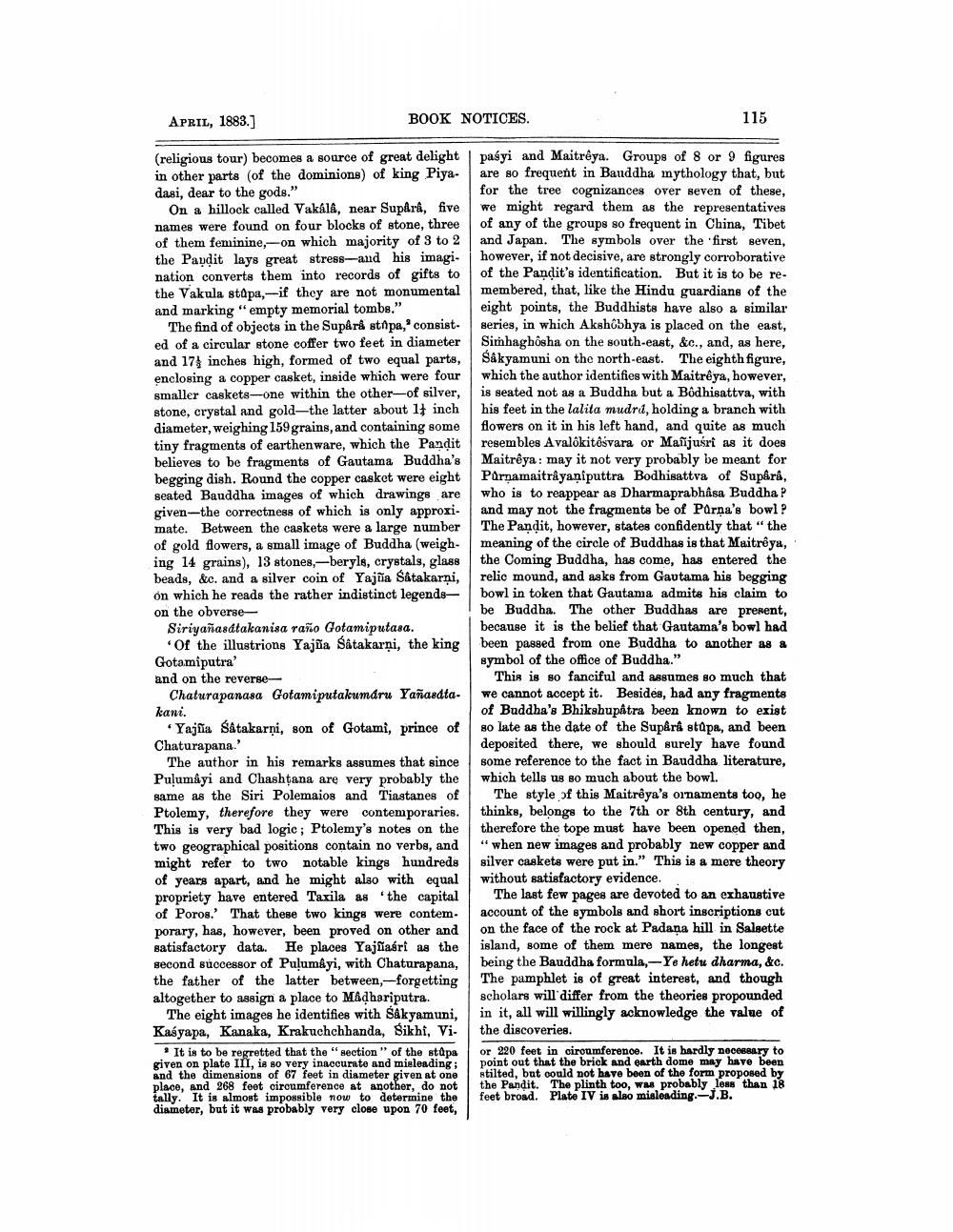________________
APRIL, 1883.]
BOOK NOTICES.
115
(religious tour) becomes a source of great delight in other parts (of the dominions) of king Piyadasi, dear to the gods."
On a hillock called Vakala, near Supra, five names were found on four blocks of stone, three of them feminine,-on which majority of 3 to 2 the Paydit lays great stress--and his imagination converts them into records of gifts to the Vakula stapa,- if they are not monumental and marking "empty memorial tombs."
The find of objects in the Supårå stipa, consist. ed of a circular stone coffer two feet in diameter and 17 inches high, formed of two equal parts, enclosing a copper casket, inside which were four smaller caskets--one within the other-of silver, stone, crystal and gold-the latter about 14 inch diameter, weighing 159 grains, and containing some tiny fragments of earthenware, which the Pandit believes to be fragments of Gautama Buddha's begging dish. Round the copper casket were eight seated Bauddha images of which drawings are given-the correctness of which is only approxi. mate. Between the caskets were a large number of gold flowers, a small image of Buddha (weighing 14 grains), 13 stones,-beryls, crystals, glass beads, &c. and a silver coin of Yajia Satakarni, on which he reads the rather indistinct legendson the obverse Siriyañasdtakanisa raño Gotamiputasa.
of the illustrions Yajña Satakarņi, the king Gotamiputra and on the reverse
Chaturapanasa Gotamiputakumdru Yañasdtakani.
Yajsia Satakarni, son of Gotami, prince of Chaturapana.'
The author in his remarks assumes that since Puļumâyi and Chashtana are very probably the same as the Siri Polemaios and Tiastanes of Ptolemy, therefore they were contemporaries. This is very bad logic ; Ptolemy's notes on the two geographical positions contain no verbs, and might refer to two notable kings hundreds of years apart, and he might also with equal propriety have entered Taxila as the capital of Poros.' That these two kings were contem. porary, has, however, been proved on other and satisfactory data. He places Yajñasri as the second successor of Puļum&yi, with Chaturapana, the father of the latter between--forgetting altogether to assign a place to Madhariputra.
The eight images he identifies with Sakyamuni, Kasyapa, Kanaka, Krakuchchhanda, Sikhi, Vi.
It is to be regretted that the "section of the stapa given on plato III, in so very inaccurate and misleading : and the dimensions of 67 feet in diameter given at one place, and 968 foot circumference at another, do not tally. It is almost impossible now to determine the diameter, but it was probably very close upon 70 feet,
paśyi and Maitreya. Groups of 8 or 9 figures are so frequent in Bauddha mythology that, but for the tree cognizances over seven of these, we might regard them as the representatives of any of the groups so frequent in China, Tibet and Japan. The symbols over the first seven, however, if not decisive, are strongly corroborative of the Pandit's identification. But it is to be remembered, that, like the Hindu guardians of the eight points, the Buddhists have also a similar series, in which Akshibhya is placed on the east, Simhaghosha on the south-east, &c., and, as here, Sakyamuni on the north-east. The eighth figure, which the author identifies with Maitreya, however, is seated not as a Buddha but a Bodhisattva, with his feet in the lalita mudri, holding a branch with flowers on it in his left hand, and quite as much resembles Avalokitesvara or Masijusri as it does Maitrêya : may it not very probably be meant for Parnamaitrậyaniputtra Bodhisattva of Supära, who is to reappear as Dharmaprabhasa Buddha P and may not the fragments be of Parna's bowl ? The Pandit, however, states confidently that "the meaning of the circle of Buddhas is that Maitreya, the Coming Buddha, has come, has entered the relic mound, and asks from Gautama his begging bowl in token that Gautama admite his claim to be Buddha. The other Buddhas are present, because it is the belief that Gautama's bowl had been passed from one Buddha to another as a symbol of the office of Buddha."
This is so fanciful and assumes so much that we cannot accept it. Besides, had any fragments of Buddha's Bhikshupatra been known to exist so late as the date of the Supra stapa, and been deposited there, we should surely have found some reference to the fact in Bauddha literature, which tells us so much about the bowl.
The style of this Maitreya's ornaments too, he thinks, belongs to the 7th or 8th century, and therefore the tope must have been opened then, " when new images and probably new copper and silver caskets were put in." This is a mere theory without satisfactory evidence.
The last few pages are devoted to an exhaustive account of the symbols and short inscriptions cut on the face of the rock at Padaņa hill in Salsette island, some of them mere names, the longest being the Bauddha formula,-Ye hetu dharma, &c. The pamphlet is of great interest, and though scholars will differ from the theories propounded in it, all will willingly acknowledge the value of the discoveries. or 220 feet in ciroumference. It is hardly necesary to point out that the brick and earth dome may have been
tilted, but could not have been of the form proposed by the Pandit. The plinth too, ww. probably less than 18 feet broad. Plate IV is also misleading.-J.B.




